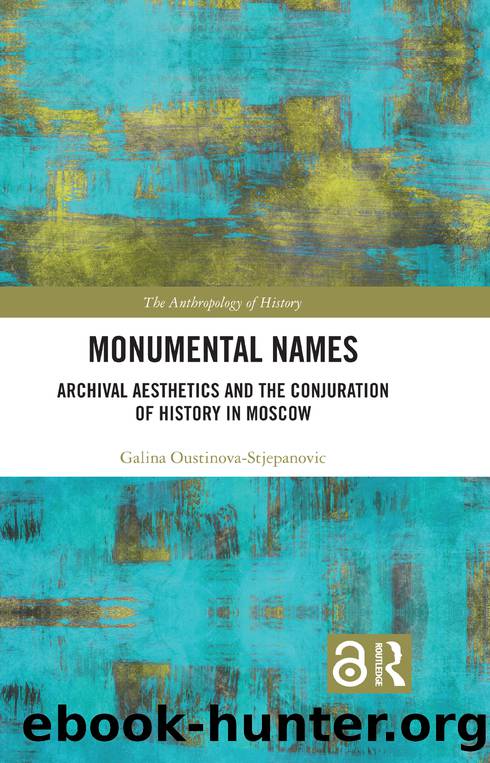Monumental Names by Galina Oustinova-Stjepanovic

Author:Galina Oustinova-Stjepanovic
Language: eng
Format: epub
Publisher: Taylor and Francis
Published: 2022-11-07T00:00:00+00:00
On Biographical Paucity of Names
Portraits Not Made is an artwork series by Robert Filliou that substitutes a portrait with a typographic painting of a name. The series is comprised of nearly blank canvases that are inscribed with names of artists, short phrases, and arrows (Fredrickson 2019: 27). Some canvases are stamped with a round seal bearing the words âPrinciple of Equivalenceâ and âPermanent Creationâ around the perimeter and three phrases: well-made, badly made, not made (Fredrickson 2019: 29). Although described as portraits, the canvases are not depictions of faces but a collage of typographic characters, letters, names, and texts, and a few photographic images of friends and families. Instead of relying on mimetic likeness, Filliouâs portraits are open-ended creations, oriented towards empty spaces and textual images rather than biographies or facial identities of subjects that Filliou had not met. As a result, portraits not made explore arbitrary links between human names and faces as people are reproduced in an alphabetic lexicon of terms such as âageâ, âadmirationâ, and âample foodâ. According to Fredrickson, names constitute a potentially endless chain of variations and contingencies that upset expectations of identifying portraits with physiognomy and personality (Fredrickson 2019: 44). Instead, Portraits No Made ask âon what basis can a name, a phrase, or a stamp on a canvas be a portrait?â (Fredrickson 2019: 44).
âKnowing someoneâs name brings us closer to a stranger and rehumanises an unknown, abstract person. It creates a mystical connection to a strangerâ, a young woman told me at the Solovetsky Stone, a monument to the Victims of Political Terror, in October 2018. From this perspective, to retain a name is to separate a human being from a presumed domain of nameless objects. Names contribute to a mystical connection with the dead because proper names are granted an immanent relation to their beings, a view that prohibits speaking names of God in different religiosities (Adorno and Horkheimer 1997: 23). A similar opinion is voiced about the Vietnam War Memorial where the semi-magical tactile contiguity of proper names with the dead is evident in visitorsâ touching and tracing a contour of inscribed names with their hands1. Recently, a selective list of names of people who died of Covid in the United States was published in New York Times (Sunday, May 24, 2020). Headlined âU.S. deaths near 100,000 an incalculable lossâ, the article suggested that the dead âwere not simply names on a list. They were usâ. In the comments, some readers claimed that personal names made the dead more intimate, more real to them. Hence, one could argue that to preserve a name is to carry out memory work that restores âthe lyric singularity of each nameâ (Harrison 1997: 189). In other words, names (just like portraits) are often given the power to forge a felt connection â a co-presence between the living and the concrete dead even when they are unknown to us.
1 I am grateful to Jonathan Spencer (Edinburgh) for this ethnographic insight. Indeed, names give rise to âa
Download
This site does not store any files on its server. We only index and link to content provided by other sites. Please contact the content providers to delete copyright contents if any and email us, we'll remove relevant links or contents immediately.
Cecilia; Or, Memoirs of an Heiress — Volume 1 by Fanny Burney(32060)
Cecilia; Or, Memoirs of an Heiress — Volume 3 by Fanny Burney(31455)
Cecilia; Or, Memoirs of an Heiress — Volume 2 by Fanny Burney(31406)
The Great Music City by Andrea Baker(30780)
We're Going to Need More Wine by Gabrielle Union(18631)
All the Missing Girls by Megan Miranda(14725)
Pimp by Iceberg Slim(13777)
Bombshells: Glamour Girls of a Lifetime by Sullivan Steve(13683)
Fifty Shades Freed by E L James(12910)
Talking to Strangers by Malcolm Gladwell(12869)
Norse Mythology by Gaiman Neil(12825)
For the Love of Europe by Rick Steves(11456)
Crazy Rich Asians by Kevin Kwan(8886)
Mindhunter: Inside the FBI's Elite Serial Crime Unit by John E. Douglas & Mark Olshaker(8699)
The Lost Art of Listening by Michael P. Nichols(7159)
Enlightenment Now: The Case for Reason, Science, Humanism, and Progress by Steven Pinker(6871)
The Four Agreements by Don Miguel Ruiz(6314)
Bad Blood by John Carreyrou(6274)
Weapons of Math Destruction by Cathy O'Neil(5829)
